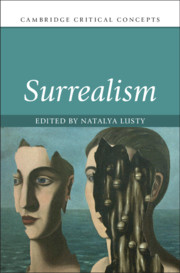20 results
Chapter 10 - Utopian Fiction
- from Part II - Authorship
-
-
- Book:
- The Cambridge Companion to William Morris
- Published online:
- 03 May 2024
- Print publication:
- 23 May 2024, pp 135-146
-
- Chapter
- Export citation
3 - The History of Sexuality and Women’s History
-
-
- Book:
- The Cambridge World History of Sexualities
- Published online:
- 26 April 2024
- Print publication:
- 16 May 2024, pp 45-67
-
- Chapter
- Export citation
Chapter 5 - Genders, Sexualities, and Decolonial Methodologies
- from Part I - Identities
-
-
- Book:
- Decolonizing the English Literary Curriculum
- Published online:
- 02 November 2023
- Print publication:
- 09 November 2023, pp 110-126
-
- Chapter
-
- You have access
- Open access
- HTML
- Export citation
4 - Il bacio mordace: Of Kissing and Biting
-
- Book:
- Monteverdi and the Marvellous
- Published online:
- 10 October 2023
- Print publication:
- 28 September 2023, pp 134-163
-
- Chapter
- Export citation
Chapter 7 - The Surrealist Novel and the Gothic
- from II - Transgression and Excess
-
-
- Book:
- A History of the Surrealist Novel
- Published online:
- 02 February 2023
- Print publication:
- 16 February 2023, pp 121-136
-
- Chapter
- Export citation
Chapter 14 - Eros: After Surrealism and Before the Revolution (1945–1967)
- from Part IV - Aesthetics and Innovation
-
-
- Book:
- Latin American Literature in Transition 1930–1980
- Published online:
- 24 January 2023
- Print publication:
- 08 December 2022, pp 229-244
-
- Chapter
- Export citation
Chapter 14 - Eros
- from Part IV - Aesthetics and Innovation
-
-
- Book:
- Latin American Literature in Transition 1930–1980
- Published online:
- 24 January 2023
- Print publication:
- 08 December 2022, pp 229-244
-
- Chapter
- Export citation
2 - The Agōn of Friendship
-
- Book:
- Christianity and the Contest for Manhood in Late Antiquity
- Published online:
- 10 November 2022
- Print publication:
- 24 November 2022, pp 103-154
-
- Chapter
- Export citation
Introduction
-
- Book:
- Boy Actors in Early Modern England
- Published online:
- 25 August 2022
- Print publication:
- 01 September 2022, pp 1-23
-
- Chapter
- Export citation
8 - War and Eros
-
-
- Book:
- The Cambridge Companion to Shakespeare and War
- Published online:
- 17 August 2021
- Print publication:
- 14 October 2021, pp 128-144
-
- Chapter
- Export citation

Surrealism
-
- Published online:
- 23 July 2021
- Print publication:
- 12 August 2021
Chapter 11 - The Other ‘Other Victorians’
- from Part III - Responses
-
-
- Book:
- Literature and Medicine
- Published online:
- 04 June 2021
- Print publication:
- 24 June 2021, pp 211-229
-
- Chapter
- Export citation
39 - Contemporary Women’s Writing in French
- from Part V - Fictions of the Fifth Republic: From de Gaulle to the Internet Age
-
-
- Book:
- The Cambridge History of the Novel in French
- Published online:
- 04 February 2021
- Print publication:
- 25 February 2021, pp 706-723
-
- Chapter
- Export citation
4 - Sugar Motherhood and the Collectivization of Love
-
- Book:
- Knowing Women
- Published online:
- 07 January 2021
- Print publication:
- 21 January 2021, pp 172-219
-
- Chapter
-
- You have access
- Open access
- HTML
- Export citation
Chapter 18 - Proximate Magic
- from Part III - Application
-
-
- Book:
- Magical Realism and Literature
- Published online:
- 22 October 2020
- Print publication:
- 12 November 2020, pp 319-336
-
- Chapter
- Export citation
Chapter 10 - Decadent Poetics after Swinburne
-
-
- Book:
- Decadence
- Published online:
- 24 September 2020
- Print publication:
- 15 October 2020, pp 183-200
-
- Chapter
- Export citation
Chapter 5 - ‘Honey secrets’
-
- Book:
- Taste and Knowledge in Early Modern England
- Published online:
- 08 October 2020
- Print publication:
- 15 October 2020, pp 183-222
-
- Chapter
- Export citation
Chapter 2 - Fair Captives and Spiritual Dragooning
-
- Book:
- British Enlightenment Theatre
- Published online:
- 21 December 2019
- Print publication:
- 02 January 2020, pp 60-112
-
- Chapter
- Export citation
Part II - Developments
-
- Book:
- Decadence and Literature
- Published online:
- 12 August 2019
- Print publication:
- 22 August 2019, pp 131-264
-
- Chapter
- Export citation
Chapter 12 - The Sexual Psychology of Decadence
- from Part II - Developments
-
-
- Book:
- Decadence and Literature
- Published online:
- 12 August 2019
- Print publication:
- 22 August 2019, pp 200-215
-
- Chapter
- Export citation



